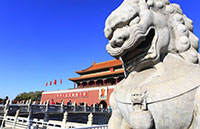Firing up an ancient art
Updated: 2016-05-17 08:05
By Cai Hong(China Daily)
|
||||||||
 |
|
One of Japanese artist Kyosuke Hayashi's creations |
Three of them are designated as National Treasures of Japan, kept in the Seikado Bunko Art Museum in Tokyo, the Fujita Art Museum in Osaka and the Ryuukouin Subtemple of the Daitokuji Temple in Kyoto. The fourth is in the Miho Museum outside of Kyoto, and the piece's existence was not widely known until fairly recently.
Up to the 1990s, it was widely believed that the techniques and quality of the Song Dynasty could not be replicated.
To learn more about the tradition and techniques of Song ceramic artisans, Hayashi traveled to Fujian to look for relics of yohen tenmoku before their glaze was changed by kiln firing.
He was lucky to find one that was exactly what he wanted.
"It was helpful in my study on replicating the yohen tenmoku ceramics," says Hayashi.
Scientists have discovered that items of jian zhan or yohen tenmoku contain a unique and incredibly difficult-to-produce crystalline formation known as epsilon-phase iron oxide.
Coincidentally, the jian zhan pieces with the highest count of this formation are also some of the most coveted for their beautiful silvery appearance.
It is believed that there was no way to control the finished product in the massive wood-burning kilns in the Song Dynasty. Because the adjustment of the fire in the kilns was left to chance when the bowls were made, their final appearance was impossible to predict.
- Canadian PM to introduce transgender rights bill
- Hillary Clinton says her husband not to serve in her cabinet
- New York cake show designs fool your eyes
- ROK prosecutors seek 17-year prison term for attacker of US envoy
- World's biggest plane leaves Australia
- Conference calls for females to be put at forefront of development

 Apple's CEO Tim Cook's eight visits to China in four years
Apple's CEO Tim Cook's eight visits to China in four years
 Annual New York cake show designs fool your eyes
Annual New York cake show designs fool your eyes
 Divers find ancient Roman cargo from shipwreck in Israel
Divers find ancient Roman cargo from shipwreck in Israel
 Taoist priests worship their ancestors in Central China
Taoist priests worship their ancestors in Central China
 The world in photos: May 9-May 15
The world in photos: May 9-May 15
 Top 10 most generous companies in China
Top 10 most generous companies in China
 Wine market shrugs off slump
Wine market shrugs off slump
 Terracotta teddy bears debut in Wuxi
Terracotta teddy bears debut in Wuxi
Most Viewed
Editor's Picks

|

|

|

|

|

|
Today's Top News
Liang avoids jail in shooting death
China's finance minister addresses ratings downgrade
Duke alumni visit Chinese Embassy
Marriott unlikely to top Anbang offer for Starwood: Observers
Chinese biopharma debuts on Nasdaq
What ends Jeb Bush's White House hopes
Investigation for Nicolas's campaign
Will US-ASEAN meeting be good for region?
US Weekly

|

|







